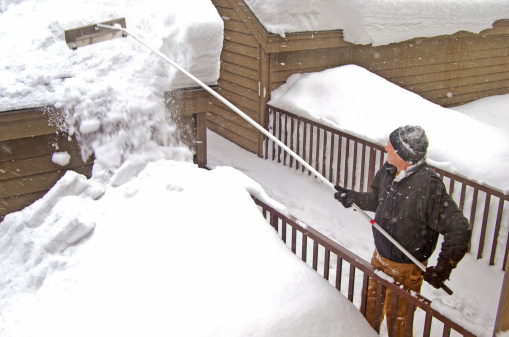Don’t believe ice is just one of those minor annoyances you must endure. Ice can wreak major havoc on your house, your lawn and your car. Sure, you can (and should!) have ample home and auto insurance to cover the costs – but you still have to assess and repair the damage caused by ice. You can save time, money and headaches by taking some simple steps to ensure you safeguard your property from ice damage.
1. Prevent Ice Dams on Your Roof
When water freezes, melts, and then refreezes on the edge of your roof it can create an ice dam. Why is this important? Ice dams can cause water to leak into your home and damage ceilings, walls, insulation and other areas, noted the Insurance Institute for Business and Home Safety (IIBHS). The reason this happens is water runs down a warm roof – which has a temperature of 32 degrees F or higher – and hits the freezing cold roof edge. The water then refreezes and expands, causing damage. A warm attic is the usual culprit.
What you can do now: Add insulation to the attic. That not only keeps you warmer inside your home, but keeps the roof colder. Also, make sure you insulate recessed lighting fixtures so they don’t heat up your attic.
What to do if a storm is imminent or just passed: Remove the snow from your roof with a roof rake, especially if 6 inches or more accumulates. Do not use a regular rake, because you can damage the shingles and gutters. The Ice Dam Guys, based in Minneapolis, Minnesota, note roof rakes are flat-headed rakes with long handles and/or extensions.
Caution: Gutters & Guards Inc. also advise homeowners to exercise ladder safety and not to climb a ladder to reach your roof. It’s too easy to fall, especially in icy or wet weather. If you can’t reach, hire a professional to clear your roof.
2. Assess the Potential for Roof Collapse
The good news: your roof can support a lot of weight. Most roofs in good condition –those that aren’t old or damaged – can support about 20-lbs. per square foot of snow, reported IIBHS. Homes in New England and other extreme weather areas are often built to withstand much more. But what does that 20 lbs. per square foot mean? Think of it this way – 10 to 12 inches of snow equals about 1 inch of water. That translates into about 5 lbs. per square feet of roof space. So unless you have more than 4 feet of snow on your roof – again, assuming the roof is not old or damaged – you are unlikely to have a cave-in.
What you can do now: Determine that your roof is in good condition. One of the easiest ways is to check your attic and look for daylight through the boards, dark streaks or stains, sagging or leaks or water damage, noted American Dream Restoration in Front Royal, Virginia. If you find problems, call a roofing professional and get the necessary repairs done.
What to do if a storm is imminent or just passed: If there is significant accumulation, remove the snow from your roof following the guidelines noted above in the section on ice dams.
Tip: Never use snow or ice melting crystals on your roof. It can cause damage to your roofing materials.
3. Keep Gutters Clear
Gutter cleaning is one of those chores that seem trivial and mundane – until your gutters back up and flood your house or saturate the ground near your home and damage its foundation. Winter means your gutters will work hard, depositing rain and melted snow away from your home.
What you can do now.: Clear your gutter of debris (if you do this yourself, make sure you properly brace the ladder, and that you wear gloves for the chore); ensure the gutter is firmly attached to the roof; take a careful look at the gutter’s seams and corners; and check downspouts (the drain that goes from the roof to the ground). Ensure you direct water at least 10 feet away from the foundation. When you clean the gutters, be sure to check for any house damage, too. Also, keep tree limbs trimmed so they don’t fall and break or clog your gutter.
What to do if a storm is imminent or just passed.: Again, clear your gutters and make sure you remove any tree limbs that could fall. Even if you regularly keep trees trimmed, take another look before a storm.
4. Protect Your Trees and Shrubs
Even evergreens can suffer limb and root damage during icy winter storms, noted The Morton Arboretum in Lisle, Illinois. Of course you’ll try to choose trees and shrubs that mesh well with the climate in which you live. But take some extra care to make sure your trees and bushes survive harsh weather.
What you can do now: Avoid fertilizing and pruning trees and bushes during late summer or early fall, recommends The Morton Arboretum. Doing so encourages growth at a time when trees and shrubs should be preserving energy and preparing for winter dormancy. But do keep watering trees and shrubs until the ground freezes.
In late fall, you can apply anti-desiccant to trees, especially evergreens. It locks water into trees and bushes for up to four months through the winter (and up to two months in the summer), according to the Missouri Botanical Garden in St. Louis.
What you can do if a storm is imminent or just passed: Apply mulch to the ground around trees and bushes to insulate the roots. Invest in burlap screens to shield evergreens from wind and salt, recommended the Missouri Botanical Garden.
5. Treat Your Patio Furniture
Ideally, you’ll bring your patio furniture inside before storms. But most homeowners don’t have the space to store large swings, chaise lounges, tables and other outdoor furniture pieces. The good news is that outdoor furniture can withstand some harsh elements. Plus you can invest in protective covers or tarps for more protection.
What you can do now: Coat your metal furniture with automotive wax to provide extra protection. Other than moving plastic furniture out of areas where it might blow away, it needs very little care prior to winter. The same is true of synthetic wicker.
What you can do if a storm is imminent or just passed: Bring your cushions indoors to help ensure mold doesn’t develop on them. Also, if your outdoor furniture has mosaic tiles, store it out of the cold weather as ice and freezing temperatures can cause tiles to dislodge.
6. Prep Your Driveway
Of course you should clear snow and ice off of your driveway and sidewalks, but just because your parents used rock salt with abandon doesn’t mean you should. Doing so can ruin your driveway and walkways whether they’re made of concrete, asphalt, brick, stone or other materials.
What you can do now: Clean your driveway. Many of us don’t give our driveways or walkways any thought but it’s a good idea to clean them every quarter or so. How you clean it depends on the material from which it’s made, of course, but power washing is a standard method. Sealing your driveway every two to five years – depending on weather, wear and tear, and the materials your driveway is made of – will help extend the life of your driveway. It’s vital to use the appropriate sealing material for your driveway type, and not over- or under-seal.
What you can do if a storm is imminent or just passed: Keep snow shovels, snow blowers and plow blades at least half an inch off the surface of drive and pathways. And don’t use rock salt. Yes, it can melt the ice but it can also damage the driveway and walkway surfaces due to the inevitable melting and refreezing that occurs. Desperate to melt the ice? Calcium chloride can work and should cause less damage when used according to the instructions.
7. Clean Your Deck
Most homeowners don’t give much thought to their decks when the weather starts to turn cold. That’s a mistake. Food and other stains aren’t just unsightly, but can seep into and damage decks. Cleaning is the first step in any deck maintenance.
What you can do now: Look for loose boards and other damage to your deck so you can correct it before inclement weather arrives. Waterproof your wood deck. You can test the effectiveness of your deck’s existing stain to determine if it requires a new staining. It’s easy. Just sprinkle water on the deck. If the water beads on the deck, it doesn’t need sealing. If the water soaks in right away, the deck is not waterproofed and needs to be sealed.
What to do if a storm is imminent or recently passed: planters and storage containers so water doesn’t accumulate and cause damage. Clear snow from the deck using a broom or shovel, but use a light touch so you don’t damage the deck. Also, shovel along the planks, not against or across them to minimize potential damage to the wood.
8. Prepare Pipes
Every winter news stories abound describing how homeowners returned to their house only to find that pipes had frozen, broken and flooded their home – destroying furniture, carpeting and mementos. Pipes in bathrooms and laundry rooms located near garages or exterior facing walls are especially vulnerable to such freezing, writes Bob Vila. That’s why it important to close crawl spaces and add extra insulation, especially in those areas.
What you can do now: Consider buying space heaters to keep such rooms warm if frigid temperatures hit. Also, never turn the heat off when you leave your home. Set the thermostat at 55 degrees, at the lowest, to keep pipes warm enough to operate properly.
What to do if a storm is imminent or recently passed: Besides using a space heater in rooms where pipes are vulnerable, open the vanity doors so that air circulates and keeps pipes warm.
9. Disconnect Your Hose and Drain Your Outside Faucets
Don’t believe those that tell you it’s fine to leave your garden hose attached and outside faucets on during winter. Cold weather causes water to expand. When that happens in a pipe, which is full of water, the pipe usually breaks.
What to do now: Drain and remove garden hoses and sprinkler systems. If your home has a separate shut-off for external faucets, turn them off and drain the water from those faucets.
What to do if a storm is imminent or recently passed: Ensure you know where the main waterline shut-off is for your house so, if a pipe breaks, you can immediately turn off the water supply.
10. De-ice Your Car Windows
On icy mornings there’s always some misguided person who chips away at the ice on their car windows with metal instruments or throws hot water on their windshield. Both methods can damage or even shatter car windows. Still, you must clean your car windows before hitting the road.
What you can do now: Ensure you have a piece of cardboard to place on your windshield before a storm hits. Lift the windshield wipers and place them on top of the cardboard to secure them to the windshield. Then when you’re ready to drive, just lift the cardboard up and drop the ice on the ground.
Tip: Do not raise your windshield wipers straight up. If ice or heavy snow falls on the wipers and forces them onto your windshield, they can crack the glass.
What to do if a storm is imminent or recently passed: Mix two parts of 70 percent isopropyl (rubbing) alcohol with one part tap water and place in a spray bottle. Spray it on the icy windshield and the ice will start melting. Let it set one minute and then scrape the ice off.
11. Protect Car Paint
Don’t ever use a snow scraper on the body of your car! That can scrape and scratch the paint.
What you can do now: Have your car thoroughly washed, waxed and sealed before snow and ice arrive. That protects your car from the elements and snow removal brushes and scrapers.
What to do if a storm is imminent or recently passed: Warm up your car before trying to remove ice. Make sure you have the doors unlocked and that the tailpipe is not obstructed.
12. Protect Your Windshield Wipers
Windshield wipers may seem like a minor consideration when an ice storm hits, but if they break or malfunction when you’re driving, causing poor visibility, you risk causing a serious accident. Never keep your wipers raised. As noted, if snow or ice hits a raised wiper it can end up breaking either or both the wiper and windshield.
What you can do now: Inspect your wiper blades to make sure the rubber is not split, chipped or peeling. Replace damaged blades if needed.
What to do if a storm is imminent or recently passed: Put socks over the wipers. That will keep the blades ice-free.
Defend Against Ice Damage
Ice due to winter weather conditions has the potential to ruin your home, car and other valuables. With a bit of planning and preparation, you can prevent most damage freezing temperatures can bring.







Thanks for the excellent advice. I like the socks idea for wipers, the alcohol and water mix, and the sugg. To wash, wax and seal before the snow blows!
Excellent and helpful tips.
Thanks.
Brian
Traveling long distance always have water, and extra warm cloths and snacks.
Really great tips!
Thank”s for the tips.
Clearing the Windshield is very important but clearing the snow from your car roof and all windows especially the back window and front side windows and back side windows.
Note: as you drive the inside of the car heats up the roof loosening the snow on the Car Roof. When you brake that big clump of snow slides forward covering your windshield and blinding you about what is in front of you, possibly causing you to hit the car in front or pedestrian crossing at corner etc.
A few extra minutes cleaning your car properly of snow and ice could save you an accident and a lifetime of agony as to who/what you hit.
P.S. Do not forget to clear your side Mirrors. Even heated side mirrors take a while to clear.
Clear your driveway especially where yo walk or drive. If it freezes over it will be hard to walk and drive in the frozen tracks. Also you may even get stuck in a cross track making you really late.
Planning ahead the night before is the best approach.
Remember when walking on ICE use the skating approach to prevent falling.
Lionel
The tips were very interesting, most of which I already knew (lived in MT all my life). One tip I found most helpful was the socks on the wiper blades, so simple and never thought of it, I’m going to do that for sure. I tried the alcohol and water in the spray bottle trick this year for the first time and it works really great.
Please don’t encourage people to warm up their car. Idling ones car is illegal in many places and causes pollution. Our condo rules prohibit warming a car up as exhaust can go into our lower units and cause carbon monoxide poisoning! I’ve lived in cold places and recommend covering windshields to prevent ice. Also I’ve successfully removed ice from both inside and outside the windshield using a small hand scraper. Warming the car is hard on the engine and it doesn’t warm up the other moving parts of the car. Best to drive slowly for a few minutes to warm up axle etc according to most car manuals.
Great Tips and a Good Read ! Helps Keep You Up To Date and Refreshed !
All off this information was very helpful for me. The use of alcohol and water on the windshield will be shared shared with my children and grandchildren. I had never heard of using the socks on the wiper blades before. And lastly the piece about the driveway will be put into use this spring/summer. Thanks for sharing these tips!
I didn’t know that using rock salts could damage your home and that it’d be better to remove the snow manually. My father still likes to use rock salt on his driveway until now and that probably explains why it needs to get repaved so often. I’ll tell him about this article and how he should hire a snow removal service instead if he can’t clear the snow at his place on his own.
This was a very helpful article. I live in the south and run a company, but we don’t have to deal with snow too much, so this really helped me to gain some knowledge, so I can help my customers out when we do get snow every once in a while. Thanks!
It was helpful when you explained that using rock salt can actually end up ruining materials like asphalt or concrete. In my opinion, it’s a good idea to have heated steps put in so the snow will melt before it even has the chance to turn into ice. This is also a good financial option because it only requires a one-time cost of having them installed instead of paying a snow removal company for their services each time. They also make a great selling point if you decide to sell the home in the future!
It’s so important not to run your wipers before totally clearing the ice from your windshield. I unwittingly burned out the motor on my wipers because the wiper got stuck on a tiny piece of ice frozen to the windshield. The burnout happens very quickly and is very costly to repair (over $400). And, there is no delaying the repair as you must not operate the vehicle without working wipers.
I tried cardboard years ago, but it froze to the wind shield. I now use a heavy-duty
windshield cover that also covers the side view mirrors, with excellent results.
Highly functional tips, thank you.
Whole House Recirculating Pumps will prevent water pipe freezing on internal water circuits. Pipe freezing was a major issue after converting to woodburner heat. Nothing short of running the furnace at high cost would keep pipes in the wall unfrozen. I have since installed another under the kitchen sink as it was freezing under the counter. Another pump solved all freezing problems plus provides instant hot water everywhere, which is a real pleasure.
Heat Tape on drain pipes keeps them flowing too.
Heat ‘cable’ along roof edge keeps ice from forming and keeps gutters thawed.
Electric Snow Shovels are light, easy to use and save your back.
James
James – Great Tips! Thanks for sharing.
Thank You For Providing Very Helpful Information. You are a Proactive Insurance Company. I Like That. Sincerely Donald Underwood.
Donald – Glad you find the information helpful!
Many thanks for all of these hints and opportunities to avoid damage! These suggestions are very helpful and avoid expense for seniors like myself who call contractors to tell us the same thing for $140 per hour!
Thanks again.
Hi Patricia – We’re glad you found the tips helpful!